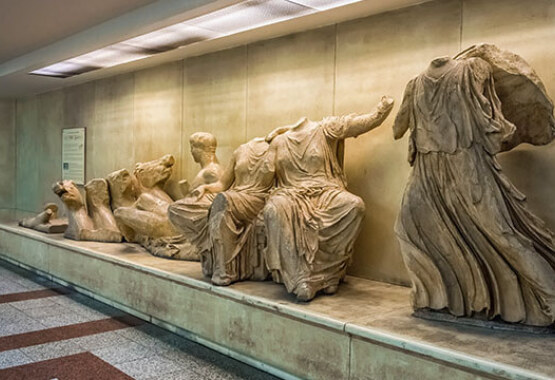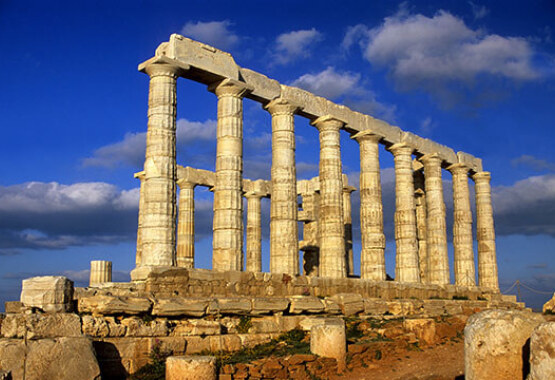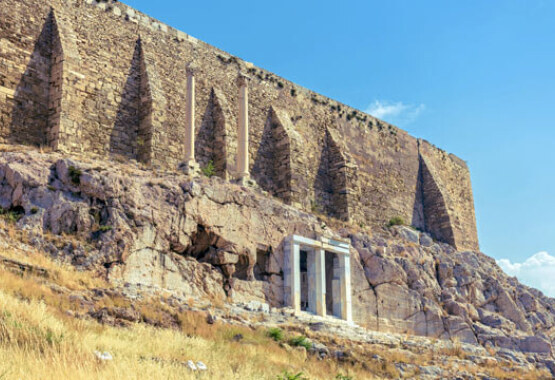
ATHENS
The foundations of these early temples and altars are preserved inside the bastion under the floor of the Classical structure. Pausanias (1, 22, 4) refers to this temple as that of the Apteros Nike, or Wingless Victory, and mentions that the cult statue of the goddess had no wings so that she would never leave Athens. Apart from the cult of Athena Nike other, earlier cults were also practiced on this site.
On the west side of the bastion was a Mycenaean double-apsed shrine and on the east side, the pre-Classical shrines of the Graces and of Hekate Epipyrgidia. The construction of the Classical temple of Athena Nike was part of the Periklean building project. Several inscriptions, mostly decrees of the city of Athens, provide information on this particular part of the project. The current temple was erected atop a new bastion created for this purpose by covering the Mycenaean bastion with neatly built isodomic walls of tufa, which made it larger and more regular in shape. The temple is a small Ionic amphiprostyle structure with four monolithic columns on either short side. The side walls of the cella end in antae, which flank a pair of pillars.
Metal railings placed between the antae and the pillars and the antae and the side columns created a sort of small pronaos. Above the epistyle, a frieze by sculptor Agorakritos depicted battle scenes between the Greeks and Persians on three sides and, on the east side, an assembly of the Olympian gods watching these battles. Little is preserved of the pediments, which are believed to have depicted a Gigantomachy on the western side and an Amazonomachy on the eastern side.
Outside the temple, to its east, was the altar. A marble parapet was built in 409 BC along the edge of the bastion for safety reasons. It consists of relief slabs, one metre high, with representations of winged Victories leading bulls to be sacrificed or sacrificing them or decorating trophies before the seated Athena. Several slabs and parts of the frieze can be admired in the Acropolis Museum; other parts of the frieze are in the British Museum.
The temple was converted into a church in the fifth century AD. In the Ottoman period it was used as a munitions store. During the siege of Morosini, in 1686, the Turks demolished the temple and used its building material to erect a fortification wall in front of the Propylaia and a tall tower, the so-called Koulas.
Temple of Athena Nike
The temple of Athena Nike stands at the southeast edge of the sacred rock atop a bastion, which in Mycenaean times protected the entrance to the Acropolis. The Classical temple, designed by architect Kallikrates and built in 426-421 BC, succeeded earlier temples also dedicated to Athena Nike. The first one of these, a mid-sixth century BC wooden temple was destroyed by the Persians in 480 BC. The eschara, the altar believed to have supported the cult statue of the goddess, dates to this period. Under Kimon, c. 468 BC, a small temple of tufa was erected around the base of the statue and a new altar was built outside the temple.The foundations of these early temples and altars are preserved inside the bastion under the floor of the Classical structure. Pausanias (1, 22, 4) refers to this temple as that of the Apteros Nike, or Wingless Victory, and mentions that the cult statue of the goddess had no wings so that she would never leave Athens. Apart from the cult of Athena Nike other, earlier cults were also practiced on this site.
On the west side of the bastion was a Mycenaean double-apsed shrine and on the east side, the pre-Classical shrines of the Graces and of Hekate Epipyrgidia. The construction of the Classical temple of Athena Nike was part of the Periklean building project. Several inscriptions, mostly decrees of the city of Athens, provide information on this particular part of the project. The current temple was erected atop a new bastion created for this purpose by covering the Mycenaean bastion with neatly built isodomic walls of tufa, which made it larger and more regular in shape. The temple is a small Ionic amphiprostyle structure with four monolithic columns on either short side. The side walls of the cella end in antae, which flank a pair of pillars.
Metal railings placed between the antae and the pillars and the antae and the side columns created a sort of small pronaos. Above the epistyle, a frieze by sculptor Agorakritos depicted battle scenes between the Greeks and Persians on three sides and, on the east side, an assembly of the Olympian gods watching these battles. Little is preserved of the pediments, which are believed to have depicted a Gigantomachy on the western side and an Amazonomachy on the eastern side.
Outside the temple, to its east, was the altar. A marble parapet was built in 409 BC along the edge of the bastion for safety reasons. It consists of relief slabs, one metre high, with representations of winged Victories leading bulls to be sacrificed or sacrificing them or decorating trophies before the seated Athena. Several slabs and parts of the frieze can be admired in the Acropolis Museum; other parts of the frieze are in the British Museum.
The temple was converted into a church in the fifth century AD. In the Ottoman period it was used as a munitions store. During the siege of Morosini, in 1686, the Turks demolished the temple and used its building material to erect a fortification wall in front of the Propylaia and a tall tower, the so-called Koulas.




